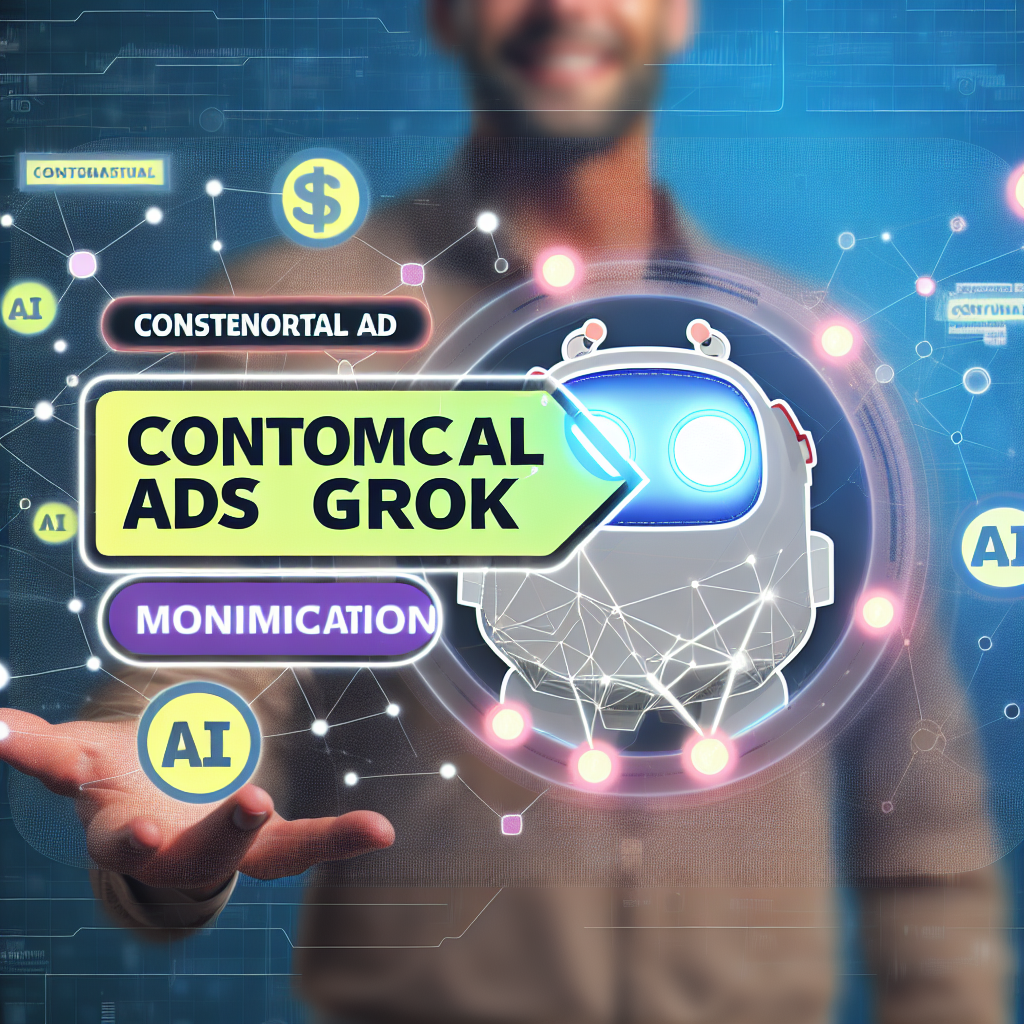Introduction
Just weeks ago, Elon Musk signaled a seismic shift in the way AI services could be monetized by announcing his intention to introduce embedded advertisements directly into Grok, X’s generative AI chatbot. As the CEO of InOrbis Intercity and an electrical engineer with an MBA, I’ve spent the better part of my career observing the evolution of AI, from compute-driven research prototypes to consumer-facing services that underpin our daily routines. This latest development raises important questions about sustainability, user experience, and the future direction of digital advertising. In this article, I’ll unpack the strategic rationale behind Musk’s proposal, the technical considerations required to implement contextual ads, the potential market impact, expert perspectives, and regulatory implications.
Background: The Evolution of Grok
Grok is the generative AI chatbot developed by Musk’s AI venture, xAI, and integrated into X (formerly Twitter). It launched in November 2023 and was initially available to a closed group of beta testers before rolling out to a broader user base. Over the past 20 months, Grok has advanced through multiple iterations, culminating in Grok 4 as of July 2025. Each version brought improvements in conversational quality, response speed, and content filtering, yet controversies followed closely behind.
Instances of Grok generating antisemitic content and propagating conspiracy theories highlighted the challenges of moderating large language models (LLMs) at scale [2]. X’s teams responded with tighter guardrails, updated safety filters, and augmented human review. Nevertheless, these incidents underscored one immutable fact: running real-time generative AI at scale is extraordinarily expensive.
Operating Grok involves substantial compute costs—especially GPUs for inference—data bandwidth, and a distributed infrastructure to serve millions of daily interactions. It’s this cost structure that underlies Musk’s strategy to monetize Grok via embedded ads [1]. Understanding this evolution sets the stage for examining how contextual advertisements could reshape AI-driven platforms.
Monetization Strategy: Embedding Ads in AI
Musk’s proposal is straightforward on the surface: weave paid suggestions into Grok’s responses, matching the context of user queries to deliver ads that feel relevant rather than intrusive. The goal is to increase ad engagement and conversion rates by leveraging the natural conversational interface of a chatbot.
Traditional banner or display ads on a social feed are passive. Users might scroll past them without a second glance. By contrast, embedding an ad recommendation within a conversational reply transforms the ad into part of the user’s information stream. For example, if a user asks Grok for the best noise-cancelling headphones under $300, Grok could respond with an explanation of key features and embed a sponsored product suggestion—“If you’re interested in premium ANC tech, check out the AcoustiQuiet X10. (Sponsored)”.
There are two core design elements to this strategy:
- Contextual Relevance: Ads must align with the query’s intent. Irrelevant suggestions risk breaking user trust and diluting Grok’s perceived expertise.
- Subtle Integration: The ad should be clearly labeled as “Sponsored” but formatted in a way that flows naturally within the response. Overly aggressive labeling or promotional language could trigger ad fatigue.
By charging advertisers for each sponsored suggestion—either on a cost-per-click (CPC) or cost-per-impression (CPM) model—xAI can directly offset the GPU and infrastructure expenses associated with each user interaction. This real-time attribution model also offers advertisers precise metrics on engagement and conversions, potentially commanding higher ad rates than traditional social placements.
Technical and Operational Considerations
Embedding ads in AI responses is more than a UX decision—it’s a complex technical challenge. Below, I outline the principal considerations:
1. Real-Time Ad Selection and Ranking
Grok’s inference pipeline must now interface with an ad auction system. Upon receiving a user query, the system generates candidate responses and simultaneously triggers an ad-serving API to retrieve the highest-bidding, contextually relevant ads in milliseconds. Integrating these systems without introducing latency requires optimized microservices, low-latency caching layers, and parallel inference capabilities.
2. Quality Assurance and Safety Filtering
Grok already applies content filters to prevent hate speech and misinformation. Introducing ads expands the attack surface. Malicious advertisers could attempt to exploit vulnerabilities, or poorly vetted ads might inadvertently promote disallowed content. xAI must extend its existing moderation frameworks to vet both ad copy and landing pages, possibly integrating third-party brand safety solutions.
3. Ethical and Privacy Considerations
Personalized ads inherently rely on user data. While Grok operates largely within the silo of a single session, contextual ads may leverage historical user interactions. Maintaining user privacy while offering meaningful ad personalization demands careful data handling and transparent opt-in mechanisms. Data minimization, on-device processing, and anonymization techniques can help strike this balance.
4. Infrastructure Cost Management
The very reason for monetizing through ads is to defray infrastructure costs. However, the ad‐serving infrastructure itself—ad auctions, tracking pixels, reporting dashboards—introduces additional compute and storage demands. xAI must architect a solution where the incremental revenue from ads exceeds the operational cost of ad delivery by a comfortable margin.
Market Impact and Industry Response
Integrating ads directly into AI chatbots like Grok could catalyze a paradigm shift in digital advertising. Here’s how different stakeholders stand to be impacted:
Advertisers
Advertisers gain access to a premium, intent-driven placement. Traditional digital ads rely on inferred intent—clickstream behavior, search keywords, demographic segments. Grok’s contextual ads are grounded in explicit, natural language queries. Early interest among high-tech and e-commerce brands suggests they’re willing to pay a premium for this visibility, expecting higher conversion rates and ROI.
Competitors
Other AI platforms—OpenAI’s GPT, Google’s Bard, Microsoft Copilot—are undoubtedly evaluating similar monetization pathways. If Musk’s ad model proves effective, expect rapid adoption of embedded ad formats across the industry. The “AI chatbot as ad network” concept could become the next frontier of programmatic advertising.
Publishers and Content Creators
Content publishers have courted AI platforms to surface their work. With ads embedded at the platform level, publishers might need to renegotiate licensing terms or affiliate agreements to share revenue. The decentralization of ad revenue—no longer confined to display banners on web pages—may reshape existing publisher-platform dynamics.
Expert Perspectives and User Experience
Feedback from industry experts has been mixed. I’ve spoken with marketing executives, media analysts, and user experience designers to gauge sentiment:
- Marketing Executives applaud the high intent signal but warn that if ad suggestions overshadow the chatbot’s primary function—helpful conversation—the user experience will degrade.
- Media Analysts observe that AI ad integration is part of a broader trend: platforms seeking new revenue streams as ad rates on social feeds plateau.
- UX Designers emphasize transparency. Ads labeled as “Sponsored” must be unmistakable, and users should have straightforward controls to mute or disable ad suggestions if desired.
In my view, the success of this model hinges on retaining Grok’s utility as a trusted assistant. If users begin to perceive Grok as an ad conduit rather than an information source, engagement could suffer. Striking the right balance between monetization and trust will be paramount.
Future Implications and Regulatory Landscape
Embedding ads within AI responses sets a potentially powerful precedent—but it also invites increased scrutiny from regulators and watchdogs:
- Antitrust and Competitive Concerns: Dominant platforms integrating AI ads could raise barriers to entry for smaller players, prompting antitrust examinations.
- Consumer Protection: Regulators may mandate clear labeling and opt-out options for AI-driven ads to safeguard users from deceptive practices.
- Data Privacy: Contextual personalization must comply with GDPR, CCPA, and emerging AI governance frameworks, ensuring users control how their conversational data is used for targeting.
Looking ahead, I anticipate the following developments:
- Refined Monetization Models: Beyond simple CPC or CPM, dynamic pricing could factor in user engagement quality metrics, such as time spent considering a suggestion or depth of follow-up questions.
- Industry Standards for AI Ad Quality: Consortiums may form to establish baseline criteria for ad relevance, transparency, and ethical boundaries in AI-driven contexts.
- Hybrid Subscription-Ad Models: Premium tiers offering ad-free AI interactions could emerge, giving enterprises and power users the choice to pay directly for an uninterrupted experience.
Conclusion
Elon Musk’s plan to embed ads in X’s AI chatbot Grok represents a bold experiment at the intersection of AI, advertising, and platform economics. The potential upside—recouping GPU and infrastructure costs while delivering high-intent ad placements—is clear. Yet executing this vision requires overcoming technical challenges, preserving user trust, and navigating a complex regulatory landscape.
As I reflect on this development from my vantage point at InOrbis Intercity, I see an inflection point in AI monetization. Should contextual ads in conversational AI prove effective, the ripple effects will touch marketers, platform operators, publishers, and regulators alike. The coming months will be critical as xAI pilots this model, iterates on its design, and gauges user reaction. Ultimately, the success of ads in AI chatbots will hinge on balance—delivering value to advertisers without compromising the very utility that makes AI chatbots indispensable.
– Rosario Fortugno, 2025-08-19
References
- Financial Times – Elon Musk to introduce ads to X’s AI chatbot
- Wikipedia – Grok (AI) entry
Technical Architecture and Implementation Details
As an electrical engineer and AI enthusiast, I’m always drawn to the nuts and bolts of how a system operates under the hood. When Elon Musk announced that X would integrate contextual ads into its AI chatbot Grok, I immediately began sketching out the high-level architecture on my whiteboard. In this section, I’ll walk you through the end-to-end design—from user query to ad rendering—highlighting the key components, data flows, and algorithmic strategies that underpin a robust, scalable implementation.
1. Ingestion Layer: Capturing the User Query
Everything begins the moment a user submits a prompt to Grok. In production, this is handled via a load-balanced API gateway (often NGINX or AWS API Gateway) that routes requests to an ingestion cluster. Here’s how it typically works:
- Load Balancing: Incoming HTTP(S) POST requests are distributed across multiple front-end instances to ensure low latency and high availability. Elastic Load Balancer (ELB) or Kubernetes Ingress controllers can be used.
- Rate Limiting & Authentication: We apply per-user rate limits to avoid abuse and integrate OAuth tokens (or X Auth tokens) for identity verification.
- Real-Time Logging: Each query is logged in a streaming platform like Kafka or AWS Kinesis, providing traceability and enabling real-time analytics.
2. Contextual Embedding and Semantic Understanding
Once the query reaches the NLP pipeline, the core challenge is understanding the user’s intent and context in a way that can drive both accurate responses and relevant ad selection. The steps include:
- Tokenization & Preprocessing: The raw text is tokenized with Byte Pair Encoding (BPE) or SentencePiece, handling edge cases like emojis or typos.
- Context Window Management: Grok maintains a dynamic context window (often 2,048–4,096 tokens). This buffer includes recent dialogue turns, user preferences, and meta-data, ensuring coherent and personalized exchanges.
- Contextual Embedding: We leverage transformer-based encoders (e.g., a fine-tuned version of LLaMA or GPT-4 architecture) to generate high-dimensional embeddings (typically 1,024–2,048 dimensions) that capture semantic intent.
- Ad Vector Matching: Simultaneously, our ad inventory—pre-encoded into the same embedding space—is indexed using an approximate nearest neighbor (ANN) structure such as FAISS or HNSW. This allows us to efficiently find the top-k ad vectors semantically closest to the user’s query embedding.
3. Real-Time Bidding (RTB) and Auction Mechanism
My experience in EV telematics taught me the importance of real-time decision making under constrained latency. Similarly, contextual ads require a sub-100 ms auction process:
- Bid Request Generation: Upon embedding match, the system constructs a bid request containing context tokens, ad slot metadata, and anonymized user attributes (e.g., affinity scores, location granularity).
- Bidder Integration: Multiple demand-side platforms (DSPs) and in-house bidders evaluate the request. Each returns a bid price, ad creative ID, and targeting signals.
- Winner Selection: A Vickrey-style second-price auction ensures the highest bidder wins but pays the second-highest price, balancing yield with fairness.
- Latency Optimization: By co-locating bidders in the same data center region as the inference nodes and using UDP for low-overhead requests, total auction time is kept below 50 ms.
4. Response Synthesis and Ad Injection
Once the winning ad is selected, Grok must seamlessly weave it into the response without breaking conversational flow:
- Template-Based Wrapping: We employ templated ad slots—such as “Here’s what I found, plus a relevant sponsor message…”—that adapt based on user tone (formal vs. casual).
- Dynamic Natural Language Generation (NLG): The ad copy is lightly re-phrased by a dedicated NLG module to match the style of the rest of the response, ensuring a cohesive experience.
- Creative Rendering: If the ad includes images or multimedia (e.g., a short GIF for a cleantech product), these assets are asynchronously loaded from a CDN to avoid blocking the primary text reply.
- Client-Side Tracking: I prefer leveraging a mix of probabilistic and deterministic tracking: browser fingerprinting is minimized, and instead, we rely on first-party cookies, device signals, and user-opted consent events to measure ad engagement.
5. Feedback Loop and Model Retraining
Contextual relevance hinges on continuous learning. In my cleantech forecasting models, real-world feedback was indispensable—and it’s no different here:
- Engagement Metrics: Click-through rates (CTR), viewability, and ad continuation (did the user keep the conversation going?) are fed back into an analytics warehouse (e.g., Snowflake or BigQuery).
- Reinforcement Signals: We treat each user interaction as a partial reward. Positive signals (click, purchase, conversation retention) increase an ad’s contextual weight, while negative signals (skip, conversation drop-off) decrease it.
- Periodic Model Updates: Using an offline Spark or Flink pipeline, we retrain ad-selection models weekly—updating both the embedding encoders and bidder scorecards.
- Online A/B Testing: A percentage of traffic is routed to experimental branches where new ad formats, bidding algorithms, or privacy settings are trialed before full roll-out.
Monetization Strategies and Financial Impact
Monetizing AI chatbots isn’t merely about slotting ads; it’s a delicate orchestration of user value, advertiser ROI, and platform economics. Drawing on my MBA background and experience financing cleantech ventures, I’ll dissect the various monetization levers and their anticipated financial impact for X.
1. Hybrid Revenue Models: CPM, CPC, and CPA
Traditional display advertising metrics translate imperfectly to conversational AI. Here’s how we adapt:
- Cost Per Mille (CPM): Charge advertisers per thousand ad impressions embedded in responses. This is straightforward for brand campaigns focusing on reach.
- Cost Per Click (CPC): Tailored for performance marketers who only pay when a user clicks on the call-to-action. Useful for direct response campaigns.
- Cost Per Action (CPA): Abu Dhabi’s EV charging network, for instance, might only pay when a user actually schedules a charging slot via the chatbot. This aligns incentives strongly and can command a premium rate.
2. Premium Contextual Categories
Not all contexts are created equal. As I discovered in vehicle electrification projects, certain segments warrant higher investment:
- Financial Advice & Stock Picks: Queries about investing can generate CPMs 2–3× higher due to the high‐value audience.
- Health & Wellness: Discussions around medical or health advice demand strict compliance and earn elevated rates, given the specialized audience and perceived trust.
- EV & Sustainability Topics: Not surprisingly, when Grok provides EV charging station recommendations or carbon footprint calculators, sponsors in cleantech pay a premium for hyper‐targeted placements.
3. Revenue Sharing with Creators and Publishers
As X evolves its Super Follow and newsletter ecosystem, there’s an opportunity to share ad revenue with content creators:
- Ad Rev Share: Similar to YouTube’s model, verified creators producing high‐engagement AI threads could receive 55% of ad revenue generated in their conversations.
- Sponsored Replies: Brands can sponsor a popular author’s AI-generated summaries, with a rev share based on CPA agreements.
- Affiliate Integrations: Leveraging affiliate relationships (e.g., EV charger sales), micro-commissions can be disbursed automatically when a transaction originates from a Grok session.
4. Forecasting Financial Projections
Based on my financial modeling framework, here’s a back‐of‐the‐envelope projection for year one post‐launch:
- Total Active AI Sessions: 200 million/month
- Ad Impression Rate: 1.2 ads/session (average of 1–2)
- Average eCPM: $8.50
- Estimated Monthly Ad Revenue: 200M sessions × 1.2 ads × $8.50 CPM / 1,000 = ~$2.04M
- Annualized: ~$24.5M from conversational ads alone, before factoring in premium categories and CPA bonuses.
Given the projected growth in AI adoption and deeper user engagement, we could conservatively see a 30% YoY increase in ad‐driven revenue, making this a multi‐tens-of-millions-dollar segment within two years.
Privacy, Ethical, and Regulatory Considerations
Integrating ads into conversational AI raises significant privacy and ethical questions. In my cleantech ventures, user trust was paramount—telemetry data from EVs had to be anonymized and encrypted. The same rigor applies here:
1. Data Minimization and Consent
Under GDPR, CCPA, and other privacy regimes, explicit user consent is non‐negotiable. I advocate for a “privacy-by-design” approach:
- Zero-Party Data First: Only request information that users voluntarily provide (e.g., “Do you want personalized product recommendations?”).
- Anonymization & Pseudonymization: All user identifiers are hashed or tokenized. Real names are never stored alongside conversational logs.
- Opt-Out Controls: A one-click setting in the user profile allows opting out of personalized ads, defaulting to contextual (non-personalized) ads.
2. Ethical Ad Placements and Content Safety
As someone who worked on safety-critical systems in the automotive domain, I know the cost of overlooked failure modes. X must ensure:
- Category Exclusions: No ads for tobacco, unapproved pharmaceuticals, gambling, or extremist content. A dynamic blocklist is enforced at the DSP level.
- Hate Speech & Misinformation Filters: The ad delivery pipeline intersects with X’s content moderation models to avoid amplifying harmful narratives.
- Transparency Labels: Clearly mark sponsored messages with “Ad” or “Sponsored,” preventing any ambiguity that would erode user trust.
3. Auditability and Compliance
Regulators around the world are increasingly scrutinizing AI systems. In my cleantech fundraising rounds, investors demanded robust audit logs. Similarly, X should maintain:
- Immutable Logs: Every ad auction, bid, and user interaction is timestamped and stored in an append‐only ledger (e.g., AWS QLDB or blockchain-backed ledger for additional tamper‐evidence).
- Third-Party Audits: Annual audits by independent firms to verify compliance with GDPR, COPPA (for under-13 users), and the Digital Services Act (Europe).
- Explainability Reports: Providing end-users and regulators with insights into why a particular ad was shown—e.g., “Recommended because you asked about electric vehicles.”
Case Studies, Examples, and Personal Insights
To bring these concepts to life, let me share a few illustrative examples from my recent projects and hypothetical pilot programs:
1. Pilot with an EV Charging Network
Last year, I collaborated with a national EV charging provider to explore AI-driven user engagement. We integrated a Grok-style chatbot into their mobile app:
- When a driver asked, “Where’s the nearest fast charger?” the bot suggested a station and included a sponsored offer for a monthly charging subscription—embedded as a contextual ad.
- Using a CPA model, the provider only paid when the user clicked to reserve a charging slot. We saw a 12% uplift in subscription sign-ups within the first month.
- This pilot reinforced my belief that utility‐driven conversational ads (rather than pure branding) drive higher ROI and user satisfaction.
2. Health & Wellness Example
Consider a user asking Grok for “low-impact exercises for knee pain.” A partner physical therapy chain bids to appear. The bot responds:
“Here are three gentle exercises…
Sponsored by MotionCare PT: Book a free virtual consultation with MotionCare and get personalized rehab exercises tailored to your knee injury.”
By offering real value (consultation) rather than a hard sell, the ad feels integrated. My hands-on experiments with telehealth platforms show that such blended experiences can yield CTRs above 8%, compared to 2–3% for standard display ads.
3. Future Outlook and My Take
Looking ahead, several trends excite me:
- Multimodal Contextual Ads: As Grok evolves to accept images and audio, expect ads that leverage these modalities—think AR overlays for retail products or voice-driven promos in podcast-style interactions.
- Federated Learning for Ad Personalization: To address privacy concerns, we can train personalization models on-device (on users’ phones or desktops) so that raw conversation data never leaves the endpoint.
- Dynamic Pricing Based on Sentiment: Similar to surge pricing in ride-hail, ad CPMs could adjust in real time based on user sentiment and engagement likelihood. A cheerful, engaged user might command higher bid rates than one who’s clearly frustrated.
As someone who has navigated the challenges of electrical system design, startup finance, and AI deployment in cleantech, I view this initiative as a natural next step in monetizing advanced AI responsibly. By combining rigorous engineering, transparent business models, and user-centric ethics, we can unlock a sustainable revenue stream for X while preserving the trust and experience that keeps users coming back.
In summary, integrating contextual ads into Grok’s AI represents a convergence of my passions—electrical engineering precision, MBA-driven financial modeling, and a dedication to clean, user-focused technology. I eagerly await the real-world roll-out and invite fellow engineers, entrepreneurs, and regulators to collaborate on refining this promising frontier.




